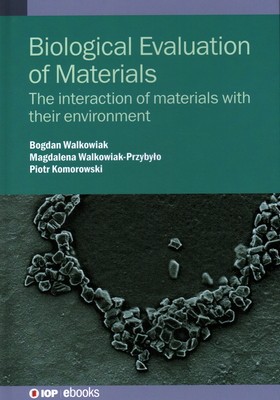
- We will send in 10–14 business days.
- Author: Bogdan Walkowiak
- Publisher: IOP Publishing Ltd
- ISBN-10: 0750326549
- ISBN-13: 9780750326544
- Format: 17.8 x 25.4 x 0.8 cm, hardcover
- Language: English
- SAVE -10% with code: EXTRA
Reviews
Description
The biological evaluation of materials involves the characterisation of materials using biological methods. At present, new materials are typically characterised using physicochemical methods. Such approaches don't account for the interactions that materials have with living organisms in their environment. This reference text covers the emerging field of materiomics: the holistic study of material function and behaviour using both physicochemical and biological methods.
The book presents a comprehensive strategy for the identification, characterisation and grouping of nanomaterials[BWI1] [BWI2] using biological methods. The focus is on methods from molecular biology, and complementary methods derived from quantum physics. The work discusses the interaction of materials with their environment, the field of materiomics, the biological recognition of materials, and the quantum basis of materials recognition by cells. The discussion of quantum mechanisms enables a deeper understanding of the interaction of biological objects with materials.
The key audience for this book includes researchers involved in the characterisation of materials, particularly biomaterials researchers and those interested in the interaction of materials science and the life sciences. The book will also be a valuable reference for postgraduate students and practitioners working in the fields of materials characterisation and biomaterials.
Key Features:
- Presents a comprehensive strategy for the identification, characterisation and grouping of nanomaterials using molecular biology, and complementary methods derived from quantum physics
- Provides coverage of the emerging field of materiomics
- Follows an interdisciplinary approach and does not require advanced understanding of mathematics
- Highly useful to all researchers involved in characterising new materials, particularly biomaterials researchers and those interested in the interaction of materials science and the life sciences
EXTRA 10 % discount with code: EXTRA
The promotion ends in 20d.23:28:24
The discount code is valid when purchasing from 10 €. Discounts do not stack.
- Author: Bogdan Walkowiak
- Publisher: IOP Publishing Ltd
- ISBN-10: 0750326549
- ISBN-13: 9780750326544
- Format: 17.8 x 25.4 x 0.8 cm, hardcover
- Language: English English
The biological evaluation of materials involves the characterisation of materials using biological methods. At present, new materials are typically characterised using physicochemical methods. Such approaches don't account for the interactions that materials have with living organisms in their environment. This reference text covers the emerging field of materiomics: the holistic study of material function and behaviour using both physicochemical and biological methods.
The book presents a comprehensive strategy for the identification, characterisation and grouping of nanomaterials[BWI1] [BWI2] using biological methods. The focus is on methods from molecular biology, and complementary methods derived from quantum physics. The work discusses the interaction of materials with their environment, the field of materiomics, the biological recognition of materials, and the quantum basis of materials recognition by cells. The discussion of quantum mechanisms enables a deeper understanding of the interaction of biological objects with materials.
The key audience for this book includes researchers involved in the characterisation of materials, particularly biomaterials researchers and those interested in the interaction of materials science and the life sciences. The book will also be a valuable reference for postgraduate students and practitioners working in the fields of materials characterisation and biomaterials.
Key Features:
- Presents a comprehensive strategy for the identification, characterisation and grouping of nanomaterials using molecular biology, and complementary methods derived from quantum physics
- Provides coverage of the emerging field of materiomics
- Follows an interdisciplinary approach and does not require advanced understanding of mathematics
- Highly useful to all researchers involved in characterising new materials, particularly biomaterials researchers and those interested in the interaction of materials science and the life sciences


Reviews